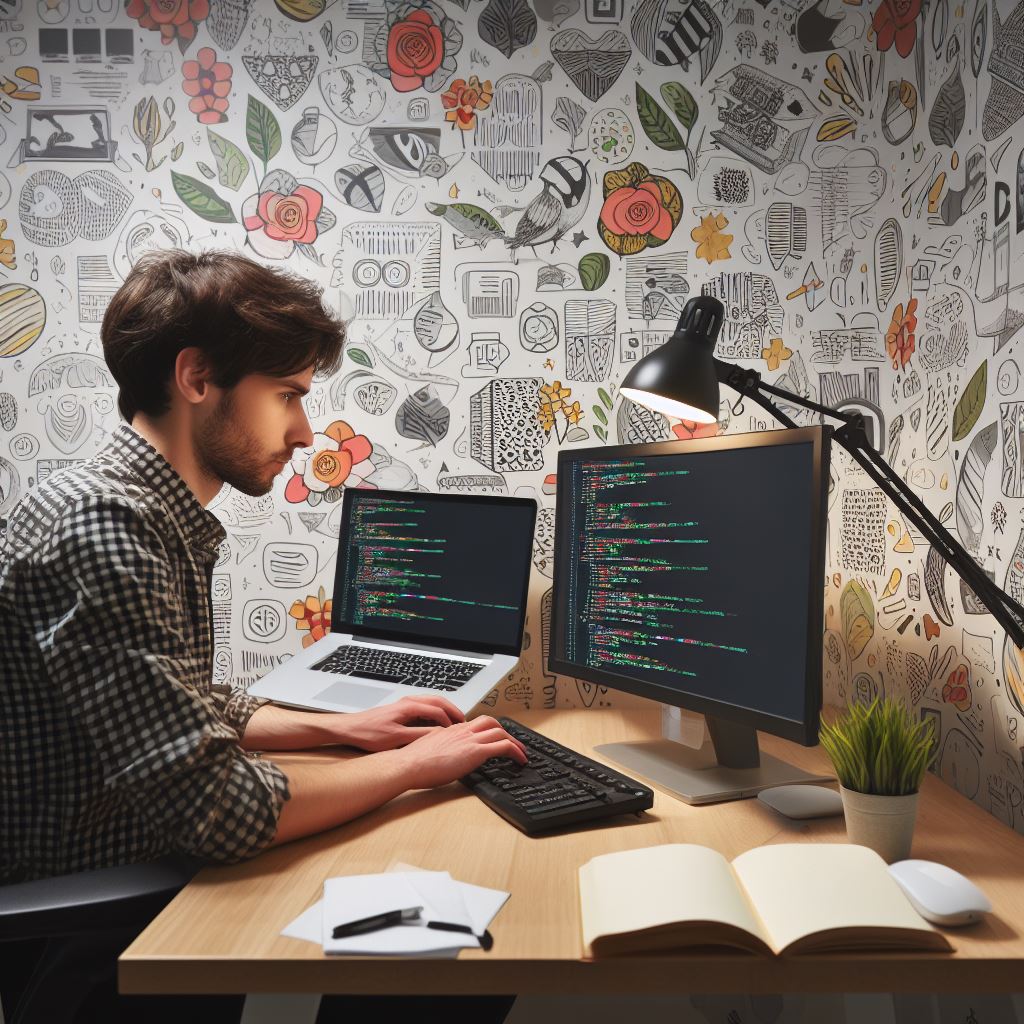Introduction
Dynamic Coding Wallpapers
Dynamic coding wallpapers are animated or interactive backgrounds that can be set on your Windows 10 desktop. These wallpapers offer a unique and visually engaging way to customize your coding environment.
Importance of Customizing Desktop Backgrounds
Customizing your desktop background may seem like a minor detail, but it can have a significant impact on your overall computing experience, especially for coders. Personalized and dynamic wallpapers can:
- Boost Motivation: Dynamic wallpapers featuring coding themes or inspirational quotes can serve as daily reminders of your coding goals and passions.
- Enhance Aesthetics: Visual appeal can make your workspace more inviting and encourage creativity.
- Improve Focus: The right dynamic wallpaper can create a harmonious and distraction-free coding environment.
- Reflect Personality: Customized wallpapers let you express your unique style and interests.
In this blog post, we’ll explore how to set up dynamic coding wallpapers on Windows 10 and harness their benefits for an enriched coding experience.
Explaining Dynamic Coding Wallpapers
Definition and Purpose
- Dynamic coding wallpapers refer to interactive backgrounds that display live code snippets on the desktop.
- The purpose of dynamic coding wallpapers is to create a coding environment without the need for a separate coding editor.
Benefits of Using Dynamic Coding Wallpapers
- Code Accessibility: Dynamic coding wallpapers provide easy access to code snippets without opening a separate application.
- Constant Exposure to Code: By displaying code on the desktop, users are constantly exposed to programming concepts, enhancing their learning experience.
- Productivity Boost: Quickly refer to code segments, functions, and algorithms right on the desktop, saving time and increasing coding speed.
- Instant Experimentation: Modify code snippets directly from the wallpaper, allowing for instant experimentation and rapid prototyping.
- Visual Aesthetics: Dynamic coding wallpapers can be personalized with custom themes, colors, and font styles to create an aesthetically pleasing coding environment.
- Motivational and Inspirational: Seeing code in action on the desktop can serve as a motivation and inspiration for coding enthusiasts.
- Easy Sharing and Collaboration: Sharing code snippets becomes effortless as the desktop wallpaper can be easily captured and shared with others.
- Customization and Personalization: Dynamic coding wallpapers allow users to switch between different programming languages or frameworks based on their preference.
- Reminders and Cheat Sheets: Users can create code snippets for frequently used commands or programming concepts, serving as helpful reminders or cheat sheets.
Overall, dynamic coding wallpapers offer numerous advantages such as easy code accessibility, improved productivity, and personalized coding experiences.
These wallpapers not only enhance coding skills but also make the process more visually appealing and engaging.
Read: Securing Your Data in a Remote Coding Environment
Getting Started with Dynamic Coding Wallpapers on Windows 10
Requirements and Compatibility
To set up dynamic coding wallpapers on your Windows 10, there are certain requirements and compatibility factors you need to consider. Here’s what you need to know:
- Operating System: Ensure that you have a Windows 10 operating system installed on your computer as dynamic coding wallpapers are specifically designed for this version.
- System Specifications: Check if your computer meets the minimum system requirements for running dynamic coding wallpapers smoothly. These include a decent processor, sufficient RAM, and adequate storage space.
- Graphics Card: Make sure you have a compatible graphics card capable of handling the dynamic coding wallpapers. This will ensure optimal performance and prevent any graphical glitches or lag.
Downloading and Installing Wallpaper Engine Software
After fulfilling the requirements, the next step is to download and install the Wallpaper Engine software, which will enable you to set up dynamic coding wallpapers. Here’s how to do it:
- Go to the official website of Wallpaper Engine and navigate to the download section.
- Click on the download button to initiate the download process.
- Once the download is complete, locate the setup file and double-click on it to start the installation.
- Follow the on-screen instructions to complete the installation of Wallpaper Engine on your Windows 10 system.
Explaining the Wallpaper Engine User Interface
Once you have successfully installed the Wallpaper Engine software, it’s time to familiarize yourself with its user interface. Here’s a breakdown of its key elements and functionalities:
- Wallpaper Library: This section allows you to browse through a wide range of dynamic coding wallpapers. You can preview them before selecting the one you prefer.
- Workspace: This area provides a visual representation of your desktop where you can see the current wallpaper and make adjustments.
- Wallpaper Settings: Here, you can customize various aspects of the dynamic coding wallpapers, such as animation speed, sound effects, and interactive elements.
- Wallpaper Browser: This feature lets you search for specific dynamic coding wallpapers using keywords or tags. It helps you discover new wallpapers based on your interests.
- Steam Workshop Integration: Wallpaper Engine seamlessly integrates with Steam Workshop, which means you can access a vast collection of user-created wallpapers.
- Wallpaper Editor: Advanced users can utilize the Wallpaper Editor to create their own custom dynamic coding wallpapers from scratch or modify existing ones.
- Performance Options: Depending on your system’s capabilities, you can adjust the performance settings to optimize the experience and prevent any performance issues.
In essence, setting up dynamic coding wallpapers on Windows 10 requires meeting the necessary requirements, downloading and installing the Wallpaper Engine software, and understanding its user interface.
Once you have completed these steps, you can enjoy a visually captivating and interactive desktop experience like never before.
Read: The Rise of Remote Coding Jobs: A 5-Year Analysis
Finding and Selecting Dynamic Coding Wallpapers
Recommended websites for dynamic coding wallpapers
When it comes to finding dynamic coding wallpapers for your Windows 10 desktop, there are several websites that are highly recommended.
These websites offer a wide range of wallpapers specifically curated for coding enthusiasts.
One of the most popular websites is CodeWall, which features a vast collection of coding-related wallpapers. They offer wallpapers that showcase various programming languages, coding patterns, and code snippets.
Tech Consulting Tailored to Your Coding Journey
Get expert guidance in coding with a personalized consultation. Receive unique, actionable insights delivered in 1-3 business days.
Get StartedThe website is designed to cater to the specific needs and preferences of programmers and developers.
Another great website is DeviantArt, a platform where artists share their work with the community. DeviantArt has a dedicated section for coding wallpapers, featuring unique and creative designs.
You can browse through the different galleries and collections to find wallpapers that catch your eye.
HackingUI is also a recommended website for dynamic coding wallpapers. It offers a wide range of wallpapers that blend coding with stunning visuals.
HackingUI focuses on providing wallpapers that represent the creativity and artistry behind coding.
Exploring different categories and themes
Once you have identified the recommended websites, it’s time to explore the different categories and themes they offer.
These categories allow you to narrow down your search and find wallpapers that align with your personal preferences.
CodeWall, for example, categorizes their wallpapers based on programming languages such as Python, Java, C++, and more.
This makes it easier for you to find wallpapers specific to the programming language you prefer or work with the most.
DeviantArt has categories like Minimalist, Sci-Fi, Abstract, and Fantasy, among others. These categories provide a diverse range of options, allowing you to choose wallpapers that suit your style and taste.
HackingUI offers categories such as Typography, Illustration, and Retro, which combine coding with different visual elements.
Exploring these categories can help you discover unique wallpapers that stand out from the usual coding backgrounds.
Previewing and selecting desired wallpapers
After exploring the categories and themes, it’s time to preview and select the wallpapers that catch your attention.
Most websites allow you to preview wallpapers before downloading them, which helps you make informed decisions.
Build Your Vision, Perfectly Tailored
Get a custom-built website or application that matches your vision and needs. Stand out from the crowd with a solution designed just for you—professional, scalable, and seamless.
Get StartedClicking on a wallpaper thumbnail will typically open a larger preview, giving you a better look at the design and details.
This preview option is crucial because it helps you determine if the wallpaper fits your screen resolution and if it resonates with your personal style.
When previewing wallpapers, pay attention to the overall composition, color scheme, and level of detail. Consider how the wallpaper will look on your desktop and if it will enhance your coding experience.
Once you find a wallpaper that you love, click on the “Download” button or follow the instructions provided by the website to save it to your computer.
In short, finding and selecting dynamic coding wallpapers for your Windows 10 desktop is an exciting process.
By exploring recommended websites, exploring different categories and themes, and previewing and selecting desired wallpapers, you can customize your coding environment to reflect your unique style and passion.
Read: Remote Coding Jobs: Legal Considerations to Keep in Mind

Customizing Dynamic Coding Wallpapers
Adjusting wallpaper settings
- Open the Windows settings and click on the “Personalization” option.
- Select the “Background” tab to access the wallpaper settings.
- Choose the dynamic coding wallpaper you want to customize.
- Adjust the position of the wallpaper by selecting “Fill,” “Fit,” “Stretch,” or “Tile.”
- Change the wallpaper color by clicking on the “Choose a fit” dropdown menu.
- Enable or disable the shuffle option to have different coding wallpapers each time.
Configuring display mode and animation options
- Navigate to the “Lock screen” tab in the Windows settings.
- Select the “Dynamic coding wallpaper” option under the “Choose your picture” section.
- Choose the display mode from the available options: “Picture,” “Slideshow,” or “Windows spotlight.”
- Customize the wallpaper animation by enabling or disabling the “Play a slide show on the lock screen” option.
Personalizing coding wallpapers with widgets and overlays
- Install a widget application from the Microsoft Store for additional customization options.
- Open the widget application and select the coding wallpaper you want to personalize.
- Add widgets such as clocks, weather updates, calendar events, or system monitors.
- Adjust the position and size of the widgets to fit your preferred coding wallpaper layout.
- Customize overlays for your coding wallpapers by using image editing software.
- Overlay coding-related quotes, code snippets, or your name to make the wallpaper more personal.
Customizing dynamic coding wallpapers on Windows 10 elevates your desktop experience. Here’s how:
- Access Windows settings through the Start menu, then “Personalization.”
- Choose a dynamic coding wallpaper and adjust position settings to your liking.
- Modify wallpaper color for a personal touch.
- Enable or disable shuffle to control wallpaper rotation.
- Customize the lock screen with dynamic coding wallpapers.
- Select display mode options such as “Picture” or “Slideshow.”
- Enhance personalization with widget applications from the Microsoft Store.
- Add widgets like clocks, weather updates, and system monitors.
- Use image editing software to overlay quotes, code snippets, or your name on the wallpaper.
Customization allows a dynamic coding environment that reflects your style and preferences, offering inspiration and motivation.
Read: 5 Most In-Demand Remote Coding Skills in 2023
Managing Dynamic Coding Wallpapers
- Adding and organizing wallpaper collections
- Setting up wallpaper playlists and randomization
- Adjusting wallpaper performance and resource usage
Managing dynamic coding wallpapers on Windows 10 allows users to personalize their desktop background with coding-related images that change dynamically.
Here are some useful tips and techniques for efficiently managing these wallpapers:
Adding and organizing wallpaper collections
To enhance your coding experience, it’s essential to create a collection of coding wallpapers.
- Start by downloading high-quality coding wallpapers from reputable websites or create your own designs.
- Once you have gathered a handful of wallpapers, create a dedicated folder on your computer for easy access.
- Organize the wallpapers within this folder into subfolders based on specific coding themes or categories.
- This organizational structure will make it convenient for you to locate and switch between different wallpapers quickly.
Setting up wallpaper playlists and randomization
Windows 10 offers built-in features to create playlists and enable randomization for a dynamic wallpaper experience.
Optimize Your Profile, Get Noticed
Make your resume and LinkedIn stand out to employers with a profile that highlights your technical skills and project experience. Elevate your career with a polished and professional presence.
Get Noticed- Open the “Settings” app and navigate to the “Personalization” section.
- Click on “Background” and select the folder containing your coding wallpapers.
- Enable the “Slideshow” option to create a wallpaper playlist.
- Customize the duration for each wallpaper and choose whether to shuffle the playlist.
- With randomization enabled, your desktop background will automatically change at regular intervals.
- You can also specify different playlists for different monitors if you have a multi-monitor setup.
Adjusting wallpaper performance and resource usage
Dynamic coding wallpapers can consume system resources, causing a slowdown in performance. Here’s how to mitigate this:
- Optimize wallpaper image files by compressing them without significant loss in quality.
- Use lightweight wallpaper formats such as JPEG or PNG to reduce memory consumption.
- Adjust the wallpaper transition settings to minimize any performance impact during background changes.
- Avoid using excessively large image files or wallpapers with complex animations.
- Consider using third-party wallpaper management software that offers advanced resource optimization features.
- Regularly check for updates to both your operating system and wallpaper management tools to ensure optimal performance.
By following these recommendations, you can efficiently manage your dynamic coding wallpapers on Windows 10. Enjoy a visually appealing and inspiring coding environment!
Troubleshooting Dynamic Coding Wallpapers
Common issues and their solutions
- Wallpaper not changing: Check if the Wallpaper Engine is running and set to change wallpapers.
- Code errors: Verify that the coding is correct and compatible with the wallpaper engine.
- Compatibility issues: Ensure that the wallpaper engine and coding language are compatible.
- Unresponsive wallpaper: Restart the Wallpaper Engine and check for any conflicting applications.
- Wallpaper lag or flickering: Adjust the wallpaper resolution to match your screen resolution.
- High CPU or memory usage: Close unnecessary background processes and reduce wallpaper complexity.
Optimizing wallpaper engine performance
- Update Wallpaper Engine: Install the latest version to benefit from performance improvements.
- Check system requirements: Ensure that your computer meets the recommended specifications.
- Close unnecessary applications: Reduce the load on your CPU and memory by closing unused programs.
- Adjust wallpaper settings: Lower the visual effects or modify the quality settings to improve performance.
- Disable unnecessary features: Turn off animations, dynamic lighting, or other resource-intensive options.
- Limit CPU and memory usage: Set the maximum CPU and memory limits in the Wallpaper Engine settings.
- Clear cache: Remove temporary files and cache data to free up system resources and improve performance.
- Optimize wallpaper coding: Streamline your code by reducing unnecessary calculations or complex loops.
- Use lightweight wallpapers: Choose wallpapers that have low CPU and memory usage for optimal performance.
- Disable live wallpapers: If performance issues persist, consider using static wallpapers instead.
Remember, troubleshooting dynamic coding wallpapers may require trial and error. It’s important to experiment with different solutions to find what works best for your system configuration.
By following these troubleshooting techniques and optimizing wallpaper engine performance, you can overcome common issues and enjoy dynamic coding wallpapers on Windows 10 without any hassle.
Conclusion
Setting up dynamic coding wallpapers on Windows 10 offers numerous benefits and possibilities. It not only adds aesthetic appeal but also enhances productivity and the overall coding experience.
With the ability to personalize wallpapers, developers are encouraged to unleash their creativity and create a coding environment that truly represents their unique style and preferences.




